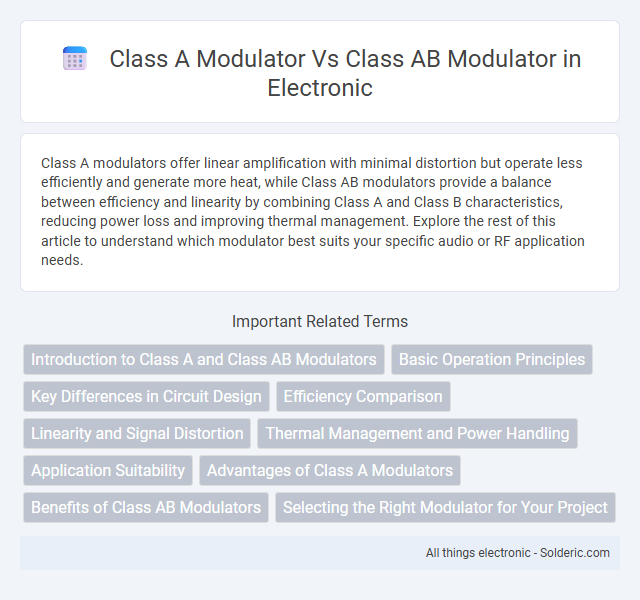Class A modulators offer linear amplification with minimal distortion but operate less efficiently and generate more heat, while Class AB modulators provide a balance between efficiency and linearity by combining Class A and Class B characteristics, reducing power loss and improving thermal management. Explore the rest of this article to understand which modulator best suits your specific audio or RF application needs.
Comparison Table
| Feature | Class A Modulator | Class AB Modulator |
|---|---|---|
| Operating Region | Conducts for full input cycle (360deg) | Conducts for more than half but less than full cycle (180deg-360deg) |
| Linearity | High linearity, minimal distortion | Good linearity, moderate distortion |
| Efficiency | Low efficiency (~20-30%) | Higher efficiency (~50-70%) |
| Power Dissipation | High power dissipation, more heat generated | Lower power dissipation compared to Class A |
| Complexity | Simple circuit design | More complex circuit design |
| Applications | Low-power, high-fidelity modulators | Moderate power modulators balancing efficiency and linearity |
Introduction to Class A and Class AB Modulators
Class A modulators operate with the transistor conducting continuously, resulting in excellent linearity but lower efficiency, which leads to higher power consumption and heat generation. Class AB modulators combine the advantages of Class A and Class B by allowing conduction over more than half the input signal cycle, enhancing efficiency while maintaining reasonable linearity. Your choice between Class A and Class AB modulators depends on the specific requirements for signal fidelity and power efficiency in your application.
Basic Operation Principles
Class A modulators operate by conducting current through the active device continuously, ensuring linear amplification with minimal distortion but lower efficiency. Class AB modulators combine the advantages of Class A and Class B, conducting current during more than half but less than the entire input signal cycle, resulting in improved efficiency while maintaining acceptable linearity. Your choice between these modulators depends on the balance you need between signal fidelity and power efficiency in your application.
Key Differences in Circuit Design
Class A modulators operate with a single transistor conducting throughout the entire input signal cycle, resulting in a straightforward circuit design but lower efficiency and higher heat dissipation. Class AB modulators combine Class A and Class B operation by using complementary transistors that conduct during different portions of the input cycle, enhancing efficiency while maintaining lower distortion. Your choice depends on balancing linearity and power efficiency, with Class A favored for simplicity and Class AB for improved performance in high-fidelity applications.
Efficiency Comparison
Class AB modulators generally offer higher efficiency than Class A modulators by combining the low-distortion benefits of Class A with the reduced power loss characteristics of Class B operation. Class A modulators continuously conduct current, resulting in significant power dissipation and lower efficiency, typically around 20-30%. Your choice of modulator impacts overall power consumption and thermal management, with Class AB modulators achieving efficiencies closer to 50-70%, making them better suited for applications requiring improved energy performance.
Linearity and Signal Distortion
Class A modulators exhibit superior linearity due to their continuous conduction over the entire input cycle, resulting in minimal signal distortion and high-fidelity output, which is ideal for precision analog applications. In contrast, Class AB modulators operate with conduction angles between Class A and Class B, offering a compromise that reduces power consumption while maintaining moderate linearity; however, they introduce some crossover distortion at the zero-crossing point of the waveform. The trade-off in Class AB modulators between efficiency and linearity makes them suitable for applications where moderate distortion is tolerable, whereas Class A modulators dominate in environments demanding minimal signal distortion and maximum linearity.
Thermal Management and Power Handling
Class A modulators exhibit continuous conduction, resulting in higher power dissipation and significant heat generation that necessitates robust thermal management solutions such as large heat sinks and active cooling. Class AB modulators combine the efficient conduction of Class B and linearity of Class A, offering improved power handling with reduced heat output and lower thermal stress, thereby simplifying thermal management requirements. Enhanced efficiency in Class AB modulators leads to better overall power handling capacity, making them suitable for applications demanding moderate thermal control and higher power efficiency.
Application Suitability
Class A modulators excel in applications requiring high linearity and low distortion, such as precision analog signal processing and high-fidelity audio transmission. Class AB modulators balance efficiency and linearity, making them suitable for RF amplification and communication systems where power efficiency is crucial without significant sacrifice in signal fidelity. The choice between Class A and Class AB modulators largely depends on the application's demands for linearity, efficiency, and power handling capacity.
Advantages of Class A Modulators
Class A modulators offer superior linearity and minimal signal distortion, making them ideal for high-fidelity audio and communication systems. Their continuous conduction mode ensures consistent signal amplification, providing enhanced accuracy in signal processing. Your choice of a Class A modulator ensures excellent performance in applications requiring low noise and high signal integrity.
Benefits of Class AB Modulators
Class AB modulators offer higher power efficiency and lower heat dissipation compared to Class A modulators, making them ideal for portable and battery-operated devices. They balance linearity and efficiency, resulting in reduced distortion while maintaining effective amplification. These characteristics extend device lifespan and improve overall performance in wireless communication systems.
Selecting the Right Modulator for Your Project
Class A modulators deliver high linearity and low signal distortion, making them ideal for applications requiring precise amplitude modulation despite their lower efficiency and higher heat generation. Class AB modulators offer a balanced trade-off between linearity and efficiency, suitable for projects where power consumption and thermal management are critical without sacrificing acceptable signal quality. Selecting the right modulator depends on prioritizing either signal fidelity (Class A) or operational efficiency and thermal performance (Class AB) based on specific project requirements.
Class A modulator vs class AB modulator Infographic

 solderic.com
solderic.com